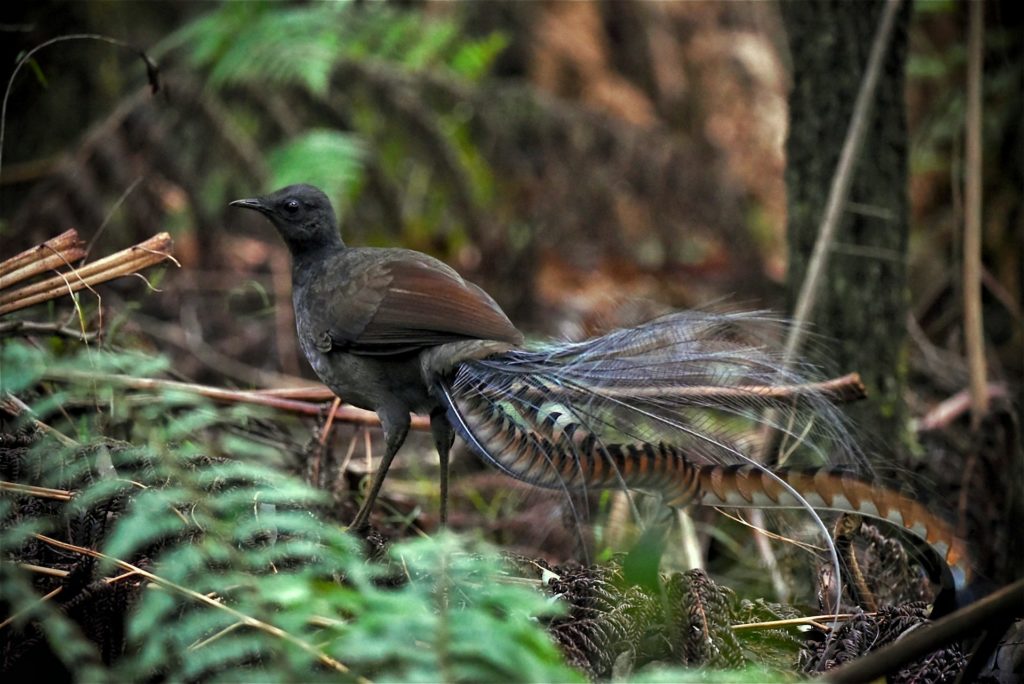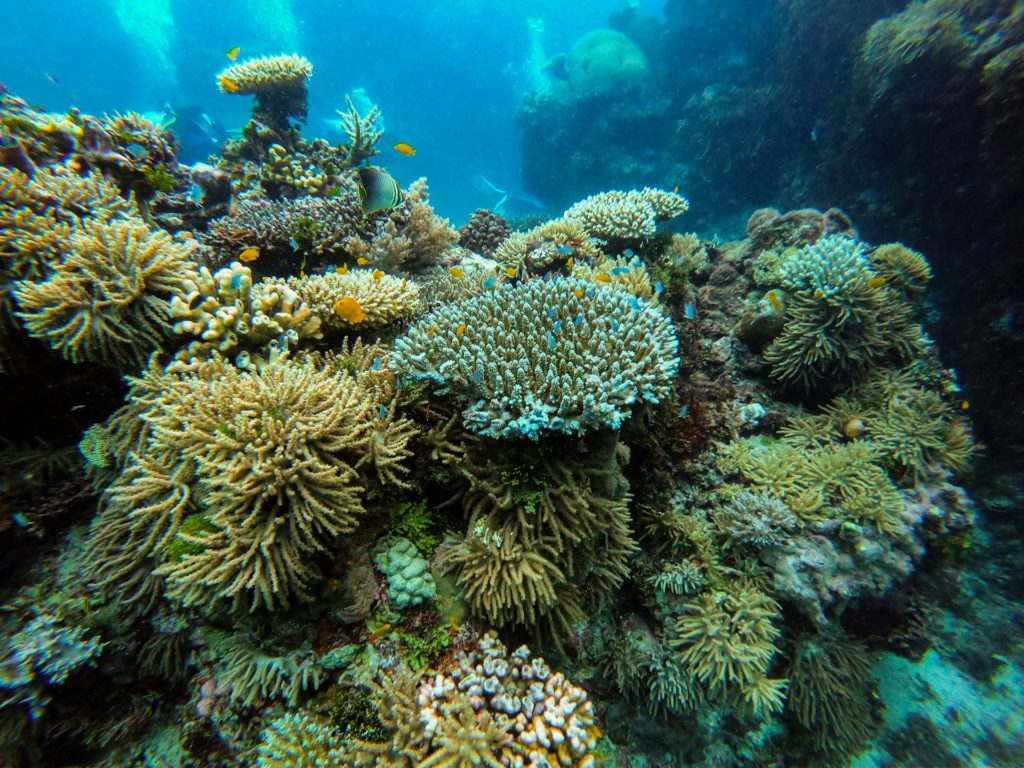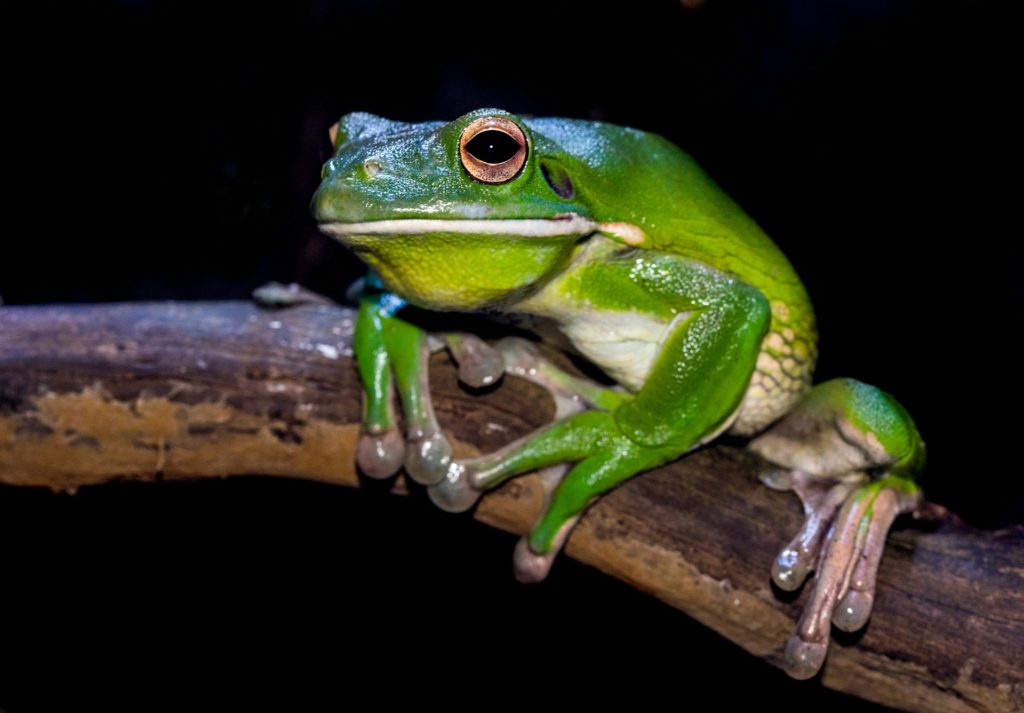Surviving an Existential Crisis: Tackling Biodiversity Loss and Climate Change
By Prof. Euan Ritchie
Professor of Wildlife Ecology and Conservation, Deakin University

The kaleidoscope of colours as one swims over a coral reef.
Thousands of flapping grey-headed flying foxes silhouettes moving across a dusk sky in Naarm (Melbourne).
The extraordinary song of a lyrebird and the smell of its forest home immediately following rain.
Being stirred and serenaded by a choir of magpies at dawn.
A gardener’s gratitude for ladybugs gobbling aphids.
Nature is truly remarkable.
Nature gives us meaning, it makes our lives richer, more magical. And of course, we are a part of nature: embedded and intertwined. It is simply nonsense to think of people and nature as separate entities. Our very existence and economies are wholly dependent on Earth’s species and ecosystems.1
But we betray and abuse this relationship: there’s no question that we are rapidly destroying our only home,2 and in turn, erasing extraordinary biodiversity which has been shaped over millions of years by evolution. Akin to burning down and bulldozing galleries and museums and the precious and unique works they contain, the environmental harm humanity inflicts is reckless, foolhardy, and unforgivable.
Humanity has brought about and is now entrenched within two existential crises: biodiversity decline and extinction, and climate change. I don’t wish to catalogue the damage, nor eulogise what’s already likely gone forever, since this is covered extensively in grim detail elsewhere. Instead, I offer personal reflections and provocations for some of the key areas that require urgent attention and change.
The critical importance and challenges of storytelling
A fundamental characteristic of humans is the value and importance we place upon storytelling. As an ecologist and conservation biologist it is confronting to acknowledge that ultimately, changing hearts and minds and overcoming the many environmental problems we confront is rarely contingent on more data collection.3 I do not seek to diminish the vital role of research for understanding our world and hopefully better informing conservation decision-making. After all, this is what I’ve been doing for most of my working life. But climate change is a matter of basic physics and chemistry.
In 1896, more than 120 years ago, Swedish scientist Svante Arrhenius outlined how increasing levels of carbon dioxide in the atmosphere would drive up global temperatures.4 And in 1974, ecologist Daniel Janzen discussed how habitat destruction would both imperil species and risk the extinction of ecological interactions, which are mostly invisible.5 It is these relationships between species — competition, predators and prey, symbioses and mutualisms, parasites and their hosts — that the health and integrity of ecosystems hinges upon. Like a complex, interwoven tapestry, pull on a thread and you risk the whole thing unravelling.
The notion that scientists should simply communicate more effectively to help solve the climate and extinction crises is also simplistic and naïve. Despite active attempts by employers and organisations to silence and suppress scientists,6 over recent decades and with the advent of modern, social, and online media, increasing numbers of us have also become expert and effective science communicators. Facebook, TikTok, X (Twitter), YouTube: scientists have embraced these platforms, which typically have audiences that dwarf those of traditional media.
But on these very same platforms, scientists now battle trolls, bots, and misinformation. Feral horses do destroy fragile alpine habitats and endanger native wildlife, cats that are kept inside to not pose a risk to native wildlife will be safer and healthier, dingoes aren’t ‘hybrid, mongrel, wild dogs’. Every day, scientists roll up their sleeves, and at times risk genuine personal and professional harm. The abuse and bearing witness to the destruction of what many of us know and love intimately can take a heavy toll.7
It is undoubtedly why poor mental health is rife among environmental and climate scientists and why many have chosen to change careers.8
Finding a voice and platform in the mainstream media is another challenge altogether. As opposed to social media, television and newsprint are dominated by a minority of moguls that have been shown to trade in misinformation. Despite surveys revealing the public have a large and unsatisfied appetite for science stories,9 this is not reflected in programming. The very real, ongoing, and accelerating decline of life on Earth is regularly hidden. Media reform laws that mandate a far greater diversity of voices and content are urgently required.

Science and politics
Inextricably linked with the challenges and complexities of media and effective science communication is our political system. In Australia, both Labor and the Liberal-Nationals coalition receive hundreds of thousands of dollars in political donations from fossil fuel companies annually.10 It should therefore come as little surprise to us then, that successive Ministers for the Environment have baulked at the proposition that they should have a legal duty of care to children, and to ensure that their decisions provide for a safe, secure, and sustainable future for all.11 It might also explain why they have celebrated UNESCO’s declaration that the Great Barrier is not in danger, despite all the evidence demonstrating it unquestionably is.12
Those that fight and protest for the environment and climate are regularly punished and locked up, while many politicians continue to ignore scientific warnings and instead lock in increasing greenhouse gas emissions and the further destruction of habitats and ecosystems, including the Great Barrier Reef.
Science and scientists will continue to be sidelined in favour of vested interests unless we see substantial reform and improvements to laws concerning political donations, truth in advertising during election campaigns, and anti-corruption.
However, the blame does not lie solely with politicians. Scientists must also bear responsibility for our predicament, and where possible, drive change. We must not reinforce simplistic and flawed narratives.
It’s been argued that the ultimate root cause of environmental and climate calamity is one of overpopulation, but this sidelines inequality. It’s a simple fact that a minority of people consume a disproportionate amount of the world’s resources, and as a result have a gigantic environmental footprint. Yes, we need to have rational and respectful discussions about what constitutes a sustainable human population size, but just as importantly we must confront the issue of consumption and the mindless pursuit of constant economic growth.
Likewise, arguing that we can’t afford to save all species and should triage ignores the fact that in Australia alone we are committing to spending hundreds of billions on nuclear submarines, fossil fuel subsidies, and tax concessions for the wealthiest.13 Yet we are told we need a nature repair market to sufficiently fund the conservation of biodiversity.14
It’s been estimated that for ~$2 billion per annum we could greatly improve the chances of survival for many of Australia’s more than 1,900 threatened species.15 There is no shortage of money, per se – the issue is what we value and what governments choose to invest in. We have some control over this of course, as each time we vote we have an opportunity to elect representatives whose values and priorities best align with ours.
It has been argued that scientists shouldn’t get involved in politics, and that we should avoid advocacy and activism. But such a notion denies history. Science and politics have always been connected, and the environment and climate are no different. Scientists are not automatons; like everyone we have personal values, and we should be prepared to state what these are and to take up the evidence-based fight for what we seek to nurture and protect.16 Environmental and conservation advocacy and activism does not automatically preclude scientific objectivity, it is a matter of being transparent and adhering to the principles, practices, and ethics of the scientific process.
A great strength of the scientific process, if practised correctly, is that it cares not for our own personal feelings, biases, and beliefs. We should always let data and evidence guide us.
Maintaining hope and driving change
In the dire predicament we find ourselves in, the risk of despondency and apathy are ever present, but I and many others within the ecological, climate and conservation communities remain hopeful. We must celebrate the wins. For example, there were once fewer than 40 northern hairy nosed wombats alive, at the time making it among the most critically endangered species in the world, but now its numbers have passed 300 and its prospects of survival are much improved.17
Furthermore, rapidly developing technologies and approaches such as artificial intelligence, drones, and genome editing, offer once unimaginable possibilities for assessing ecosystems and managing and conserving species, and ultimately, even more conservation success stories.
Along the way, we should also support each other to take calculated risks, and learn from, not punish, our failures. Far too often the conservation community turns on its own. Yes, we should try and resurrect a thylacine-like animal, because whether we achieve the ultimate goal, the advances made along the way will almost certainly benefit and help conserve living species. The thylacine de-extinction project is not a distraction, nor does it take money away from other more pressing needs: rather the failures to care, act and invest have existed for a long time and have other root causes.

We must continue to tap into the many positives of citizen science. The success of the Australian Museum’s frog id app (> 670,000 calls submitted, > 1,000,000 frogs and over 200 species confirmed to date) is genuinely inspiring. This program has contributed many good news stories for frogs, including following the devastation of the 2019-20 fires, where the persistence of the vulnerable southern barred frog, and endangered mountain frog and giant barred frog were confirmed.18
Most importantly, we have so much still to learn, and great opportunities exist to do things differently. Nowhere is this more obvious in Australia. First Nations peoples have cared for Country for more than 60,000 years, but cultural practices and values continue to be affected by the ravages of colonialism, and attitudes and actions that persist to this day.19 For conservation to advance we must reconcile with this continent’s history, and as new environmental laws take shape, Aboriginal and Torres Strait Islander peoples must be active and adequately supported participants and drivers of change.20
Our environment will never be the same as it was, or how many of us might remember it, and we should mourn and not forget what our collective actions have caused. But the choices we make now will determine the future we inherit. Far from feeling that all is lost, speak and act for the voiceless, and care for, and defend what you love.
Euan Ritchie is a Professor of Wildlife Ecology and Conservation at Deakin University and a Eureka Award-winner for Environmental Research.
References:
- Erickson, J. D. (2022, November 11) The inconvenient truth of Herman Daly: There is no economy without environment. The Conversation. theconversation.com/the-inconvenient-truth-of-herman-daly-there-is-no-economy-without-environment-193848
- Intergovernmental Science-Policy Platform on Biodiversity and Ecosystem Services. (2019). Global Assessment Report on Biodiversity and Ecosystem Services. ipbes.net/global-assessment
- Toomey, A. H. (2023). Why facts don’t change minds: Insights from cognitive science for the improved communication of conservation research. Biological Conservation, 278, 109886. doi.org/10.1016/j.biocon.2022.109886
- The Nobel Prize in Chemistry 1903. (2019). NobelPrize.org. nobelprize.org/prizes/chemistry/1903/arrhenius/biographical/
- Lurgi, M. (2019, May 30). Habitat loss doesn’t just affect species, it impacts networks of ecological relationships. The Conversation. theconversation.com/habitat-loss-doesnt-just-affect-species-it-impacts-networks-of-ecological-relationships-117687
- Driscoll, D. A., et al. (2020). Consequences of information suppression in ecological and conservation sciences. Conservation Letters, 14(1). doi.org/10.1111/conl.12757
- Pienkowski, T., et al (2023). Supporting conservationists’ mental health through better working conditions. Conservation Biology, 37(5). doi.org/10.1111/cobi.14097
- Hance, J. (2017, August 17). All work, no pay: the plight of young conservationists. The Guardian. theguardian.com/environment/2017/aug/17/all-work-no-pay-the-plight-of-young-conservationists
- Biddle, N. (2023, November 20). Aussies profess a strong interest in science. What Australia Thinks. ANU Poll. whataustraliathinks.org.au/data_story/aussies-profess-a-strong-interest-in-science/
- Tomkins, M. (2023, January 31). Dirty and Dark – political donations from the fossil fuel industry. Market Forces. marketforces.org.au/politicaldonations2023/
- Seccombe, M. (2023, August 5). The fight to enforce a climate duty of care. The Saturday Paper. thesaturdaypaper.com.au/news/environment/2023/08/05/the-fight-enforce-climate-duty-care#hrd
- Hoegh-Guldberg, O. (2023, August 1). Out of danger because the UN said so? Hardly – the Barrier Reef is still in hot water. The Conversation. theconversation.com/out-of-danger-because-the-un-said-so-hardly-the-barrier-reef-is-still-in-hot-water-210787
- Ritchie, E. (2023, May 2). Australia being unable to afford greater environmental protection is a government myth that refuses to die. The Guardian. theguardian.com/commentisfree/2023/may/03/federal-budget-2023-australia-being-unable-afford-greater-environmental-protection-myth-refuses-die
- Maron, M., & Evans, M. C. (2022, October 27). The government hopes private investors will help save nature. Here’s how its scheme could fail. The Conversation. theconversation.com/the-government-hopes-private-investors-will-help-save-nature-heres-how-its-scheme-could-fail-193010
- Wintle, B. A., et al. (2019). Spending to save: What will it cost to halt Australia’s extinction crisis? Conservation Letters, 12(6). doi.org/10.1111/conl.12682
- Garrard, G. E., et al. (2015). Beyond Advocacy: Making Space for Conservation Scientists in Public Debate. Conservation Letters, 9(3), 208–212. doi.org/10.1111/conl.12193
- Robinson, L. (2021, May 7). ‘Precious, eccentric, easy to love’: Northern hairy-nosed wombat numbers reach 300. ABC News. abc.net.au/news/2021-05-07/rare-hairy-nosed-wombat-numbers-reach-300/100120212
- Rowley, J., & Cornwell, W. (2020, September 27). Australians recorded frog calls on their smartphones after the bushfires – and the results are remarkable. The Conversation. theconversation.com/australians-recorded-frog-calls-on-their-smartphones-after-the-bushfires-and-the-results-are-remarkable-146578
- Smith, B., et al. (2023, October 2). “The boss of Country”, not wild dogs to kill: living with dingoes can unite communities. The Conversation. theconversation.com/the-boss-of-country-not-wild-dogs-to-kill-living-with-dingoes-can-unite-communities-214212
- Ritchie, E., (2023, November 16). 5 things we need to see in Australia’s new nature laws. The Conversation. theconversation.com/5-things-we-need-to-see-in-australias-new-nature-laws-217271








